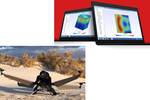NASA provides $45 million boost to U.S. small businesses
Three-hundred and sixty five small business proposals were selected for SBIR and STTR programs based on technical merit and commercial potential, including six composite companies.

Photo Credit: NASA
According to NASA, businesses are vital to its mission to expand humanity’s presence in space and to improve life on Earth. NASA announced on March 25 that it has selected 365 U.S. small business proposals — including six composite companies — for initial funding from the agency’s Small Business Innovation Research (SBIR) and Small Business Technology Transfer (STTR) program, a total investment of more than $45 million.
“At NASA, we recognize that small businesses are facing unprecedented challenges due to the pandemic,” says Jim Reuter, associate administrator for the agency’s Space Technology Mission Directorate (STMD). “This year, to get funds into the hands of small businesses sooner, we accelerated the release of the 2021 SBIR/STTR Phase I solicitation by two months. We hope the expedited funding helps provide a near-term boost for future success.”
NASA selected 289 small businesses and 47 research institutions to receive Phase I funding this year. More than 30% of the awards will go to first-time NASA SBIR/STTR recipients. “We are excited to have a large cohort of new small businesses join the NASA family via the SBIR/STTR program,” Reuter says.
Through the program, NASA says it works with U.S. small businesses and research institutions to advance cutting-edge technologies. The agency provides up to $125,000 for companies to establish the merit and feasibility of their innovations. Phase I SBIR contracts are awarded to small businesses and last for six months, while Phase I STTR contracts are awarded to small businesses in partnership with a research institution and last for 13 months. Based on their progress during Phase I, companies may submit proposals to subsequent SBIR/STTR opportunities and receive additional funding.
NASA selected proposals to receive funding based on technical merit and commercial potential. The selections span the breadth of NASA missions to empower the agency’s work in human exploration, space technology, science and aeronautics. Composite companies under the STTR program:
- AnalySwift LLC (West Jordan, Utah, U.S.) teams with Purdue University (West Lafayette, Ind., U.S.) to develop an efficient high-fidelity design tool for tailorable composites.
- Composites Automation LLC (Newark, Del., U.S.) and the University of Delaware to develop design and analysis tools for ultra-thin and tailorable composites made from the Tailorable universal Feedstock for Forming (TuFF) material (developed under a recent DARPA program by academic partner University of Delaware-Center for Composites Materials (UD-CCM)).
- M4 Engineering Inc. (Long Beach, Calif., U.S.), in partnership with Virginia Tech (Blacksburg, Va., U.S.) and San Diego State University (subcontractor, Calif., U.S.), will develop software for design of complex aerospace composite structures with variable fiber tow steer and curvilinear stiffeners.
- Raven 3D LLC (Norman, Okla., U.S.) and the University of Oklahoma-Norman to develop a large-format additive manufacturing (LFAM) system for the in-situ fabrication of a high-heat-flux ablative thermal protection systems (TPS).
- RED3D Inc. (Houston, Tex., U.S.), in collaboration University of Tennessee-Knoxville proposed to create an open-source modification of the company’s industrial 3D printer, and in conjunction develop printable, high temperature hybrid thermoset (HT2) materials.
- Luna Innovations (Roanoke, Virg., U.S.), teaming with the University of Alabama (Huntsville) which will provide NASA with lightweight solar and electric sail embedded fiber-optic sensors for control and ancillary functions.
NASA says the small businesses and research institutions selected are as varied as the technologies they will develop. Hailing from 38 states, Washington, D.C. and Puerto Rico, they include women-owned, minority-owned and veteran-owned small businesses, as well as Minority Serving Institutions (MSIs) and other types of research organizations.
The program is enhancing its efforts to further increase STTR participation by MSIs, including historically black colleges and universities, by launching two pilot initiatives. Under a cooperative agreement, NASA will work directly with MSI STEM Research and Development Consortium (MSRDC) to increase its audience’s participation in STTR. Additionally, the program will collaborate with NASA’s Minority University Research and Education Project (MUREP) to offer research planning grants and incentivize partnerships between MSIs and small businesses. The grants will also let MSIs develop plans for proposing to an STTR solicitation subtopic.
“NASA SBIR/STTR interfaces with entrepreneurs pushing the boundaries of innovation,” says Program Executive Jason L. Kessler. “We’re proud to partner with a diverse group of innovators and expand the reach of NASA across the country.”
NASA’s SBIR/STTR program is part of STMD and managed by NASA’s Ames Research Center in California’s Silicon Valley.
Related Content
3D-printed CFRP tools for serial production of composite landing flaps
GKN Aerospace Munich and CEAD develop printed tooling with short and continuous fiber that reduces cost and increases sustainability for composites production.
Read MoreOptimized approach to predict delamination failure in CFRTP structures
ARRK Engineering and Mitsui Chemicals improved delamination prediction accuracy to help optimize absorbed energy/failure load for an overmolded TAFNEX CF/PP UD tape bumper beam.
Read MorePlant tour: BeSpline/Addcomp, Sherbrooke, QC, Canada
Composites automation specialist increases access to next-gen technologies, including novel AFP systems and unique 3D parts using adaptive molds.
Read MoreOptimizing a thermoplastic composite helicopter door hinge
9T Labs used Additive Fusion Technology to iterate CFRTP designs, fully exploit continuous fiber printing and outperform stainless steel and black metal designs in failure load and weight.
Read MoreRead Next
ElectraFly, AnalySwift win U.S. Air Force STTR grants
Winning concept proposals include CBAM fabrication of aircraft parts, use of an infusion process for larger parts and development of an integrated computational blade engineering (ICBE) framework.
Read MoreSpintech awarded two U.S. STTR program contracts
Spintech partners with UDRI, an eVTOL OEM and Aurora Flight Sciences to explore manufacturing methods and materials for optimized eVTOL aircraft components and production.
Read MoreAll-recycled, needle-punched nonwoven CFRP slashes carbon footprint of Formula 2 seat
Dallara and Tenowo collaborate to produce a race-ready Formula 2 seat using recycled carbon fiber, reducing CO2 emissions by 97.5% compared to virgin materials.
Read More

























